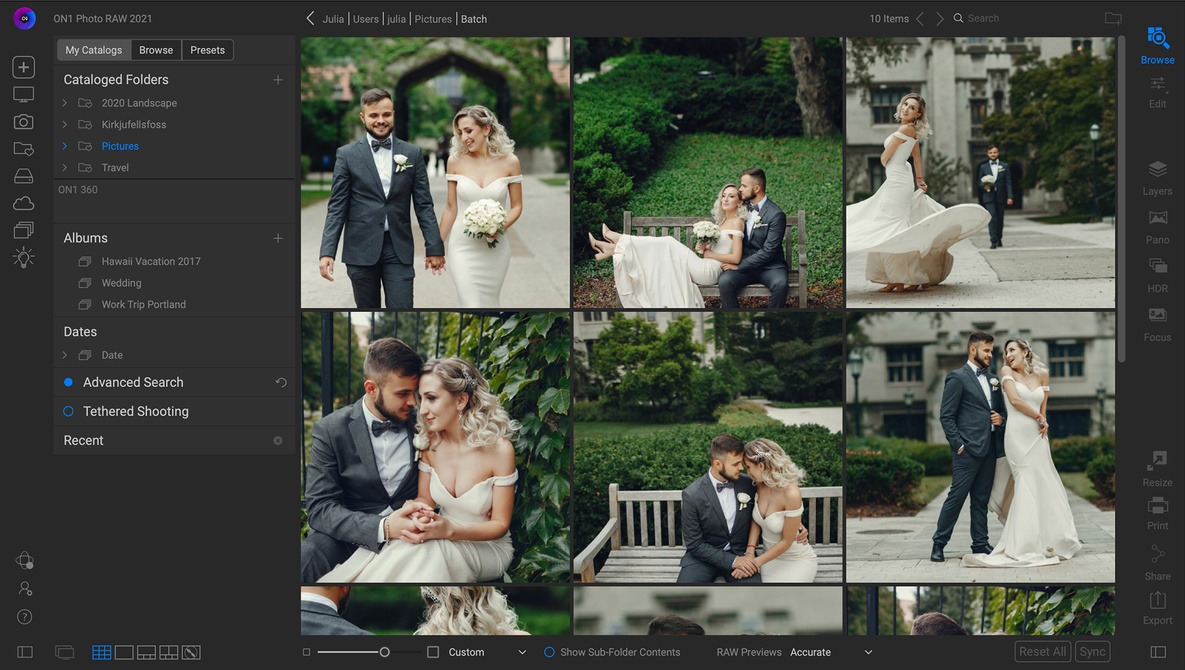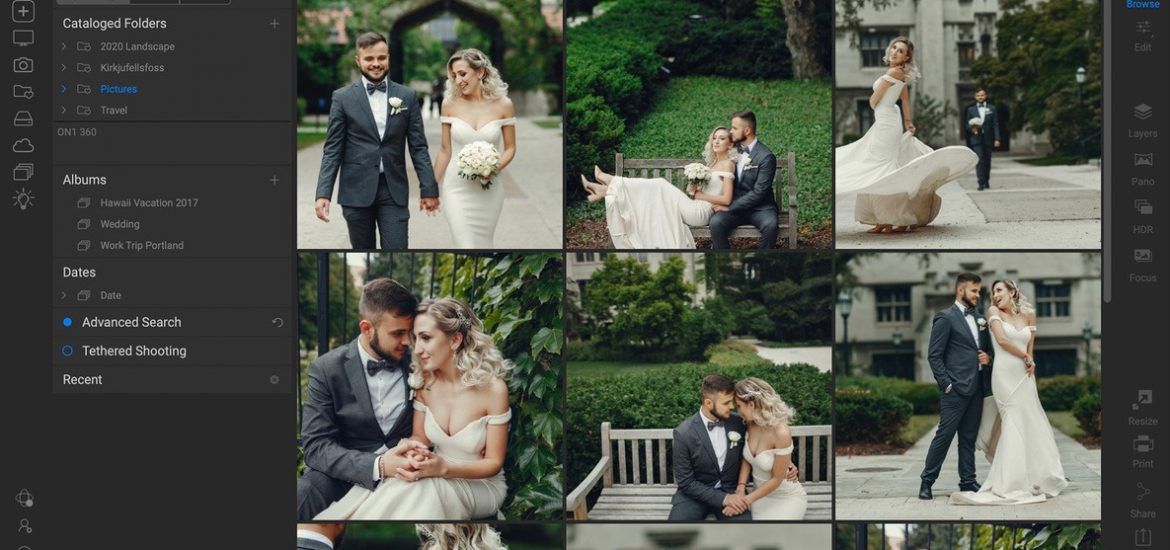
On1 Photo Raw 2021 has come a long way over the last few years. Is it now a viable alternative to both Lightroom Classic and Photoshop?
What Is On1 Photo Raw 2021?
If you are not familiar with it, On1 Photo Raw is an asset management, file browsing, raw development, layers-based image editing, portrait enhancing, resizing tool all rolled into one. It is available with a perpetual license and with a subscription service. If you subscribe to either the monthly or annual plans, you will always get the latest major upgrades of the software at no extra cost. These plans also allow you to sync photos, edits, presets, and more across your computers and mobile devices. Like Lightroom, it has a phone app too that can synchronize with the computer.
The 2021.5 update for On1 Photo Raw is now available. I’ve used On1 software in its various guises alongside other developing and editing tools for years. It’s changed dramatically in that time, and it now has a lot going for it. For example, the edge-finding capabilities of the Perfect Brush are superb, and adjustment layers like Dynamic Contrast give unique results.
Without mentioning names, I’ve had some issues with other development software being quite clunky, and I have a relatively powerful machine. But On1 2021.5 runs smoothly on my computer.
Unlike the Adobe photographer’s package, all its functionality comes in one program; switching between modules is much faster than jumping between Adobe’s software.
In appearance and feel, both the Browse Module and the Develop tab within the Edit module are much closer to Lightroom than they are to Capture One or Affinity. As with every raw-processing tool, it gives different results from its competitors. I would not say these are better or worse, simply different. To my mind, that is a good thing, as it allows the photographer to produce their own look that is unlike the majority’s.
Although the terms are often used interchangeably, I differentiate between developing and editing a photo. I think of both being processing steps with the former being the non-destructive adjustments carried out in the raw stage, while editing is changes made to digital images, such as JPEGS, PNGs, and TIFFs. All photo editing in On1 is non-destructive, carried out using layers, and conversion from raw to an image file is at the end of processing.
Who Is On1 Aimed At?
On1 is aimed at all levels of user, with a range of simple, one-click filters as well as completely manual adjustments that include layers and masks. If you are familiar with Lightroom and Photoshop, then you will find the transition to On1 a simple one. If you are new to photo development and editing, On1 has a great range of video tutorials on its website.
Organizing and Browsing
The Browse module is a hybrid catalog and file browser. In much the same way as Lightroom creates Collections, On1 calls them Albums. Indeed, On1 provides a tool for importing the collections from Lightroom for those wishing to migrate to this program.
Portrait Module
ON1 Portrait AI claims flawless retouching. I am not a great fan of these sorts of filters, although I appreciate others love them. But the adjustments available here can be as subtle or heavy as your tastes dictate. Furthermore, independent adjustments per face means that each face in a group photo can be individually enhanced.
Automatic settings can remove fine blemishes, while larger changes can be made using the content-aware eraser and clone stamp. They work similarly to those found in Photoshop. Adding fill-light can lighten the face and other tools allow the photographer to re-sculpt the face to thin the jawline or balance eye sizes.
Automatic eye detection and enhancements brighten the whites and sharpen irises. Likewise, teeth and lips can be detected and adjusted automatically too. With Batch Processing, one can process an entire folder of photos, which is a huge time-saver.
Tool Improvements
Spot Healing Brush
On1 claims a new approach to removing distractions like dust spots, power lines, and unwanted people from your photos. By painting over a distraction, a matching area of your photo is blended on top to replace it. Then, you can adjust the pixels used to hide a distraction and adjust both the opacity and blending of that edit. Trying this, it worked seamlessly.
There are two healing modes. The content-aware mode blends with the surrounding pixels and the traditional clone stamp give aligned cloning, useful for copying patterns and lines.
Custom Brush Shapes
On1 says brushing has taken a “quantum leap in control and creativity.” The latest version included a number of custom brushes, and you can create and import your own. This is similar to Photoshop but something that is not possible in Lightroom. On1 has also added Flow, Angle, and Stamping Rate control. Custom brushes also have pressure sensitivity too. You can also create a preset that stores your brush tip and all the brush properties.
Other features
Full-Screen Preview is now available, which I found was a big omission in previous versions. As with Lightroom and Photoshop, this mode allows you to hide everything except your photo, removing the distracting panels and seeing your photo filling the screen.
There is also a Quick Slideshow feature. That gives a full-screen slideshow complete with user-adjustable delay and dissolve transition.
The Camera-Based Presets allow you to automatically apply adjustments to photos from a specific camera. If you always find yourself making the same adjustments, just making a preset and applying it to photos from that camera speeds up your workflow. Again, this is a feature that is in Lightroom and where, historically, On1 lagged behind but has now caught up.
Color-Sensitive Gradient Masks are straight, reflected, or round. These are re-editable and blendable using brush masks. The color sensitivity of On1’s Perfect Brush, which I think has been one of its most powerful features, can be used with gradient masks. The tool can detect the color under the gradient. It then applies the mask to only that color range. In other words, it detects edges. This makes masking complex borders, like trees against the sky, much easier than it is with many other processing, development, and editing programs.
Batch HDR and Pano can now batch processing your HDR images and panoramas. I can see this is a big time-saver for real estate and landscape photoshoots.
Color Fill Layers are available. For reasons unknown, this feature was removed in a previous version of On1 Photo Raw, and many will applaud its return.
The Replace Color Filter can change the hue of an object to any new color, useful for working on eyes, flowers, and so on.
User Interface Improvements
Based on user feedback, On1 says they have improved common controls like sliders to be more precise. They have given the interface a longer area for labels, allowing them to be more descriptive. They have also changed the Layers and the Edit module tabs, so they don’t scroll out of view on small displays or when there are large stacks of filters.
Interactions With Other Apps
Besides Lightroom and Photoshop, there is now plug-in Support for Affinity Photo and Corel Paint Shop Pro, so you can open On1 from those. I was also able to open raw files and PSDs in On1 and send images from On1 into the Topaz and DXO software as well, of course, Lightroom Classic and Photoshop.
In summary
On1 is designed as a standalone package, but it works well as a plugin for other programs too. It’s versatile and holds its own against other apps and even exceeds them in some areas. There is a 14-day trial available from the On1 website, and it is affordable; packages cost less than the Adobe equivalents. If you are looking for a change or wanting to get into raw development, I have no qualms in recommending it.
The 2021.5 upgrade is free to those who already have bought the On1 Photo Raw 2021 perpetual license and the subscription packages.
Whether the functionality of On1 is enough to tempt you away from the program you already use depends upon the features you need. For example, it doesn’t have equivalents of Lightroom’s Map, Book, or Web modules, nor does it have the advanced graphics capabilities of Photoshop; I would not suggest it as a tool for my son’s digital art for college. However, I don’t use any of those features and other respected apps like Capture One and Affinity lack them too. On1 does have greater functionality than Capture One and Affinity.
It also depends upon whether you like the results that On1 produces over any other software. This, of course, is subjective.
Is it a viable alternative to Lightroom and Photoshop? For photography, my answer to that is yes.
